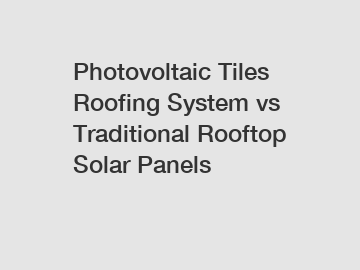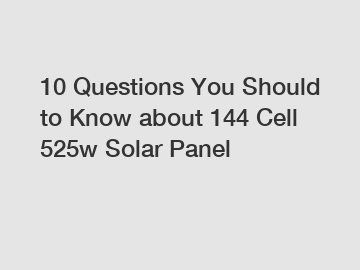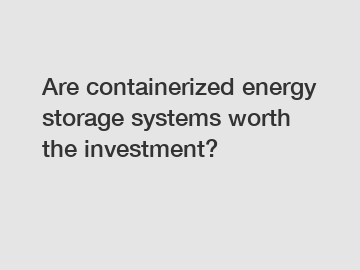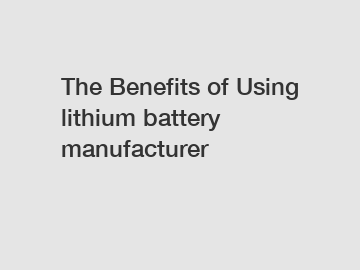How Solar, Energy Storage, and EV Charging Work Together
How Solar, Energy Storage, and EV Charging Work Together
How Solar, Battery Energy Storage, and EV Charging Work Together
Installing a solar photovoltaic system on your property can reduce energy costs as well as mitigate your organization's environmental impact. While solar is highly effective on its own, even more financial and environmental benefits can be unlocked when combined with battery energy storage and electric vehicle (EV) charging. Here's how these different technologies work together to maximize sustainability and manage costs.
If you want to learn more, please visit our website.
Battery Energy Storage and Solar-Powered EV Charging
First, let's dive into these technologies a bit deeper to explore what they are and how they integrate with solar energy.
A battery energy storage system is a clean energy asset installed on your property that can intake energy generated by your solar arrays and store it for later use. Typically, this is done when the solar system is producing more electricity than your building is using. A battery energy storage system consists of multiple individual batteries housed within a weatherproof enclosure that's normally sited alongside a building or in a parking lot.
Electric vehicle charging stations are installed on properties to accommodate EV drivers who need to replenish their cars in between trips. Workplaces, municipalities, and multi-unit dwellings are just a few types of locations where EV chargers make sense. When charging stations are installed together with solar, the energy the system generates can be used to power the chargers.
Using an EV as a Solar Battery
In some cases, an electric vehicle can function similarly to an energy storage system by storing excess solar electricity in its battery and then dispatching it back to the building to help power its loads. This capability is called bidirectional charging and is becoming increasingly beneficial to owners who want to maximize the usefulness of their clean energy assets. Not all EVs and EV chargers are capable of bidirectional charging, but more are expected to support it in the coming years. For more hardware information, check out our article on how much commercial EV charging stations cost.
Benefits of Combining Solar, Energy Storage, and EV Charging
When you pair solar with battery energy storage and electric vehicle charging, you can take advantage of more benefits compared to if you leveraged just one of these assets alone. Let's take a look at some of the ways combining multiple technologies can improve sustainability as well as financial outcomes.
Reduced Energy Costs
An onsite solar system with energy storage installed creates more flexibility in terms of when you're able to use the energy that's generated. Under normal circumstances, solar production begins as the sun rises in the morning, peaks at midday, and tapers off toward the evening as the sun sets.
With energy storage, any energy that's generated in excess of what your facility consumes during the day can be banked and used to fulfill energy needs during times of lower solar production, thereby limiting or avoiding grid electricity consumption.
This practice is especially useful in hedging against time-of-use (TOU) utility charges, allowing you to use stored energy when electricity is most expensive. Energy storage also enables 'peak shaving,' or using stored energy to lower your facility's monthly peak energy usage, which utilities often charge on a higher rate.
Money-saving tactics such as these can also reduce your carbon footprint. Extending the use of solar energy with energy storage decreases your reliance on the utility grid, and thus, fossil fuels.
Optimized EV Charging
Adding electric vehicle chargers to a solar-plus-storage system provides valuable optimizations. For starters, it allows you to use more clean solar energy and less fossil-fuel energy from the grid to power your EV charging stations ' making the technology truly 'green' and strengthening your sustainability profile.
Another big benefit is cost savings through load management. When you choose PowerFlex as your EV charging provider, you leverage PowerFlex X', our intelligent adaptive energy management platform that orchestrates solar, energy storage, and EV charging stations as a unified system.
Using patented Adaptive Load Management® algorithms, the platform ensures EVs are charged without overloading your electrical system or incurring expensive peak demand fees from your utility company. These efficiencies allow PowerFlex to install more charging stations with less infrastructure upgrades, saving you up 60% on implementation costs.
Energy Resiliency Through Microgrids
When solar, energy storage, and EV charging technologies are tied together into a microgrid, your building becomes resilient and self-sustaining in the face of utility disruptions such as extended power failures caused by bad weather or equipment breakdowns.
A microgrid has the ability to isolate from the larger power grid and uses a combination of the solar array, stored battery energy, and a traditional generator to power your building's critical operations (which may also include EV chargers if your business depends on electrified fleet vehicles).
PowerFlex X coordinates all energy assets in a microgrid to ensure efficient and sustainable continuity of operations ' intelligently alternating between solar, battery, and generator energy to power your building in the most cost effective and environmentally friendly way.
Virtual Power Plant Participation
Combining energy assets (also referred to as distributed energy resources, or DERs) on your property facilitates participation in virtual power plants (VPPs). These are aggregations of DERs that are owned by businesses and organizations like yours.
Participating in a VPP not only allows owners to benefit from their DERs in the ways explained above, but also enables them to monetize DERs and access new revenue streams. Opportunities include participating in demand response programs, which pay companies for curtailing their energy consumption when demand on the grid is high.
For more information on virtual power plants, be sure to check out our guide.
Trust PowerFlex to Help You Combine Solar, Energy Storage, and EV Charging
Interested in implementing a combination of solar, battery energy storage, EV charging, or more on your property? Our experts at PowerFlex can design a system that fits your financial and environmental goals. Contact us now to get started.
Additional reading:3KW Off Grid Inverter vs. On Grid: Which is Best?
The Ultimate Guide to 14.3kWh LiFePO4 Batteries
Is DIY Battery Kit Worth the Investment for Businesses?
Is C&I Electricity Revolutionizing the Way We Power Our World?
Ultimate Guide to 250W Polycrystalline Solar Panels
Top DIY Battery Box Kit Options Revealed
Unlocking the Power of 390 Watt Solar Panels: Everything You Need to Know
潞安 Product Page
How to choose the best battery for a solar energy system
There are certain specifications you should use when evaluating your solar battery options, such as how long the solar battery will last or how much power it can provide. Below, learn about all of the criteria that you should use to compare your home energy storage options, as well as the different types of solar batteries.
Whether you choose a battery manufactured by a cutting-edge startup or a manufacturer with a long history depends on your priorities. Evaluating the warranties associated with each product can give you additional guidance as you make your decision.
Many different types of organizations are developing and manufacturing solar battery products, from automotive companies to tech startups. While a major automotive company entering the energy storage market likely has a longer history of product manufacturing, they may not offer the most revolutionary technology. By contrast, a tech startup might have a brand-new high-performing technology, but less of a track record to prove the battery's long-term functionality.
Your solar battery will have a warranty that guarantees a certain number of cycles and/or years of useful life. Because battery performance naturally degrades over time, most manufacturers will also guarantee that the battery keeps a certain amount of its capacity over the course of the warranty. Therefore, the simple answer to the question 'how long will my solar battery last?' is that it depends on the brand of battery you buy and and how much capacity it will lose over time.
For most uses of home energy storage, your battery will 'cycle' (charge and drain) daily. The battery's ability to hold a charge will gradually decrease the more you use it. In this way, solar batteries are like the battery in your cell ' you charge your each night to use it during the day, and as your gets older you'll start to notice that the battery isn't holding as much of a charge as it did when it was new. For example, a battery might be warrantied for 5,000 cycles or 10 years at 70 percent of its original capacity. This means that at the end of the warranty, the battery will have lost no more than 30 percent of its original ability to store energy.
A battery's round-trip efficiency represents the amount of energy that can be used as a percentage of the amount of energy that it took to store it. For example, if you feed five kWh of electricity into your battery and can only get four kWh of useful electricity back, the battery has 80 percent round-trip efficiency (4 kWh / 5 kWh = 80%). Generally speaking, a higher round-trip efficiency means you will get more economic value out of your battery.
The depth of discharge (DoD) of a battery refers to the amount of a battery's capacity that has been used. Most manufacturers will specify a maximum DoD for optimal performance. For example, if a 10 kWh battery has a DoD of 90 percent, you shouldn't use more than 9 kWh of the battery before recharging it. Generally speaking, a higher DoD means you will be able to utilize more of your battery's capacity.
Most solar batteries need to retain some charge at all times due to their chemical composition. If you use 100 percent of a battery's charge, its useful life will be significantly shortened.
A battery with a high capacity and a low power rating would deliver a low amount of electricity (enough to run a few crucial appliances) for a long time. A battery with low capacity and a high power rating could run your entire home, but only for a few hours.
While capacity tells you how big your battery is, it doesn't tell you how much electricity a battery can provide at a given moment. To get the full picture, you also need to consider the battery's power rating. In the context of solar batteries, a power rating is the amount of electricity that a battery can deliver at one time. It is measured in kilowatts (kW).
Capacity is the total amount of electricity that a solar battery can store, measured in kilowatt-hours (kWh). Most home solar batteries are designed to be 'stackable,' which means that you can include multiple batteries with your solar-plus-storage system to get extra capacity.
As you consider your solar-plus-storage options, you'll come across a lot of complicated product specifications. The most important ones to use during your evaluation are the battery's capacity & power ratings, depth of discharge (DoD), round-trip efficiency, warranty, and manufacturer.
As electric vehicles become more popular, more companies are dedicating significant research and development funds to developing batteries, and they're expanding into the energy storage business. Tesla is the first mainstream example (with their Powerwall battery), but Mercedes-Benz and BMW are also bringing standalone batteries to the market in .
How long do solar batteries last?
There are two ways to answer this question and the first is to determine how long a solar battery can power your home. In many cases, a fully charged battery can run your home overnight when your solar panels are not producing energy. To make a more exact calculation, you'll need to know a few variables, including how much energy your household consumes in a given day, what the capacity and power rating is for your solar battery and whether or not you are connected to the electric grid.
For the sake of a simple example, we'll determine the size of a battery needed to provide an adequate solar plus storage solution with national average data from the U.S. Energy Information Administration. The average U.S. household will use roughly 30 kilowatt-hours (kWh) of energy per day and a typical solar battery can deliver some 10 kWh of capacity. Thus a very simple answer would be, if you purchased three solar batteries, you could run your home for an entire day with nothing but battery support.
In reality, the answer is more complicated than that. You will also be generating power with your solar panel system during the day which will offer strong power for some 6-7 hours of the day during peak sunlight hours. On the other end, most batteries cannot run at maximum capacity and generally peak at a 90% DoD (as explained above). As a result, your 10 kWh battery likely has a useful capacity of 9 kWh.
Ultimately, if you are pairing your battery with a solar PV array, one or two batteries can provide sufficient power during nighttime when your panels are not producing. However, without a renewable energy solution, you may need 3 batteries or more to power your entire home for 24 hours. Additionally, if you are installing home energy storage in order to disconnect from the electric grid, you should install a few days' worth of backup power to account for days where you might have cloudy weather.
Solar battery lifespan
The general range for a solar battery's useful lifespan is between 5 and 15 years. If you install a solar battery today, you will likely need to replace it at least once to match the 25 to 30 year lifespan of your PV system. However, just as the lifespan of solar panels has increased significantly in the past decade, it is expected that solar batteries will follow suit as the market for energy storage solutions grows.
Proper maintenance can also have a significant effect on your solar battery's lifespan. Solar batteries are significantly impacted by temperature, so protecting your battery from freezing or sweltering temperatures can increase its useful life. When a PV battery drops below 30° F, it will require more voltage to reach maximum charge; when that same battery rises above the 90° F threshold, it will become overheated and require a reduction in charge. To solve this problem, many leading battery manufacturers, like Tesla, provide temperature moderation as a feature. However, if the battery that you buy does not, you will need to consider other solutions like earth-sheltered enclosures. Quality maintenance efforts can definitely impact how long your solar battery will last.
If you want to learn more, please visit our website pv energy storage charging system.
Is New 1MW Solar System Transforming Energy?
Which Pv Module Oem is the Most Eco-Friendly?
Everything You Need to Know About 48v 280ah LiFePO4 Batteries
Revolutionizing Energy Management: Key Benefits and Challenges?
Everything You Need to Know About 390W Solar Panels: Efficiency, Cost & Installation Tips
DIY Battery Box Kit: How to Choose, Build & Install at Home
Why Pv Os is essential for customers?









Comments
0